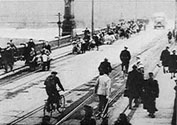

Links
Short History of Pomerania: ContentPommern nach 1945: Diese Seite in Deutsch
Gross Tuchen in Eastern Pomerania: The Expulsion 1945
Pomeranian_Griffin: Worldwide Group of Pomeranian History, Culture and Genealogy

8. Pomerania divided between Germany and Poland (since 1945)
Not only all of Germany, but also Pomerania, was divided in 1945. The three major powers that won the Second World War held a conference at Potsdam (July 17,1945, to August 2, 1945) that expanded Poland to the west, where it reached the border formed by the Oder-Neisse line. The area east of it (including Stettin) came under Polish administration. First it seemed that Stettin would remain with Germany, but then the proposed border became more specific. In October of 1945 Poland took over Swinemuende, calling it Swinoujscie, and then Stettin was occupied in the middle of November. The new border was confirmed by the Goerlitzer Agreement on July 6, 1950, by the German Democratic Republic or GDR (the former communist part of Germany), but it was not until 1990 that international law recognized the west border of Poland and that of Germany as being final and inviolable. In the five years up until the autumn of 1950 about 1.5 million humans were cruelly forced to flee, leaving scarcely two million people in what used to be Pomerania. Poland had taken over the area assigned to Stettin, Koeslin, and Danzig. This division may prove to be more thorough and lasting than in centuries past.
In July of 1945 the Soviet Military Administration confirmed that west of the demarcation line, a part of Hither Pomerania had been combined with Mecklenburg, formed originally in 1934 from Mecklenburg-Schwerin and Mecklenburg-Strelitz, into the country Mecklenburg-Vorpommern. At that time the country was about 8125 square miles and had more than two million inhabitants, including numerous refugees who soon constituted 42.2% of the population.
The country was immediately communist controlled and became part of the "German Democratic Republic" in 1949. As early as September 1945 a land reform in Vorpommern was accomplished by expropriating all agricultural enterprises larger than 250 acres (less remuneration). This most disputed measure kept its validity up to 1989/90 and later. Two free elections were held in 1946 (September 15 as well as October 20) to select the federal parliament. In the following February 25 the allied control council dissolved the former country of Prussia. It was March 1, 1947, that the federal state government erased the name Vorpommern in the new state name of Mecklenburg-Vorpommern. By July 23,1952, the five countries of the "German Democratic Republic" were to be divided into 14 districts. Mecklenburg-Vorpommern was divided into the districts of Schwerin, Rostock and Neubrandenburg. In an attempt to erase all contacts and memories of Pomerania, the Pommern Evangelist Church had to change its name to the Evangelist Regional Church of Greifswald. So it was that in 1971 there was created a working group "Church History" that served as the historical conscience and helped to keep the Pomeranian identity alive.
The communist system broke down; the border with West Germany (the Federal Republic of Germany) was opened November 9, 1989. After a peaceful revolution the German Democratic Republic joined the Federal Republic of Germany on October 3, 1990. As part of the 1952 dissolved 5 states, Mecklenburg-Vorpommern did too. All 5 new states elected Land Parliaments on October 14,1990. Mecklenburg-Vorpommern received a constitution, which was accepted by its population on June 12, 1994. Article 75 expressed the desire that both regions of the north German state of the Federal Republic be modeled after Prussia and the north Rhine Westphalia. The new federation adopted native and very popular symbols for the flag. Vorpommern took a silver coat of arms on a blue and white background with a gold-enriched red griffin.
Supplement of the Publisher:
After 1945 Eastern Pomerania and the Stettin area west of the Oder River, occupied by Poland, were divided between the Polish voivodships of Szczecin/Stettin, Koszalin/Koeslin and Slupsk/Stolp. Smaller portions fell to Gorzow/Landsberg, Pila/Schneidemuehl and Gdansk/Danzig. In 1999, as part of a general administrative reorganization, the 49 Polish provinces were reduced to 16. Among them are now "West Pomerania" with the capital Stettin, and "Pomerania" with the capital Danzig. West Pomerania covers essentially the earlier district of Stettin. Stolp and Danzig as well as parts of Ebling and Bromberg (in other words, Eastern Pomerania as well as parts of West Prussia and what is Pomerelia) is the province "Pomerania". Beside that the term "Pomerania" still appears in a third Polish province name: Kujavian-Pomeranian.
Short History of Pomerania:
Content